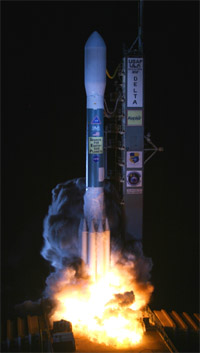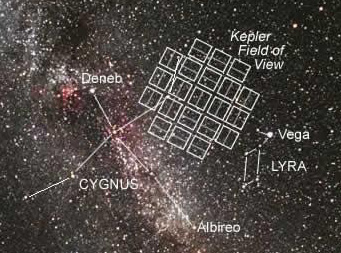If you ever get the chance to witness a nighttime satellite launch, do it.

Sixty-two minutes after rocketing into space atop this Delta II vehicle on March 6, 2009, the Kepler reached its assigned orbit around the Sun.
Carleton Bailie / United Launch Alliance.
I've only seen one, back in 1978, but the image of that muscular Atlas booster lighting up the darkness with a pillar of flame will forever be seared in my mind.
I was waxing nostalgic last night while watching the televised liftoff of NASA's Kepler spacecraft. Right on schedule, at 10:49 p.m. EST, the mission's Delta II rocket sat momentarily engulfed in a fireball of its own making before easing upward and roaring off into black sky. It was beautifully clear over southern Florida. Tracking cameras easily showed the Delta's two sets of strap-on boosters peel away from the main rocket, their fuel spent. I even saw the first-stage engine's shutdown far out over the Atlantic.
Kepler isn't your typical spacecraft, the kind that whizzes around every 1½ hours or so in a planet-hugging orbit. Instead, it has become a solar satellite, trailing Earth by some 1,000 miles (1,600 km) for the moment and stretching that to millions in the months ahead. Project designers chose this tail-chasing-dog approach in order to give the craft a view that's virtually unobstructed.
Nor is Kepler a typical mission — not that "typical missions" are uninteresting or unimportant. It's a planet hunter, pure and simple. Kepler will continually monitor the brightness of stars and pick out the ones that periodically dim ever so slightly — signaling that an alien world is passing across its star's face and thus blocking a tiny fraction of its light.

The fields of view of Kepler's 42 detectors sample a rich area of the Milky Way where mission scientists hope to monitor the light from 100,000 stars to distances of 3,000 light-years. Click here to see a larger version.
NASA / Carter Roberts
In about three months, once engineers have checked out its electronics and tweaked settings, NASA's newest space observatory will slew over to the Cygnus-Lyra border and then just stare, and stare, and stare some more. Kepler's telescope, 36 inches (95 cm) in aperture, will watch an estimated 100,000 stars in 42 detector fields totaling an amazing 105 square degrees. It all seems so simple, yet in some form or another this mission has been on the drawing board of its champion and lead scientist, William Borucki (NASA-Ames Research Center), for 17 years.
We'll be hearing lots more about and from Kepler in the months ahead, as it starts to rack up assorted "hot Jupiters" orbiting close to their parent stars and, Borucki hopes, a handful of Earth-size worlds in about three years' time. For now, enjoy this replay of the launch — and imagine yourself craning your neck to watch it soar into space as your toes wriggle in the warm beach sand.
 9
9
Comments
Lawrence Larmore
March 8, 2009 at 4:12 am
I've been waiting for this for over 50 years. Thank you, all the people who made it possible.
You must be logged in to post a comment.
Rod
March 8, 2009 at 5:08 pm
Racking up more hot jupiters does not seem like the way to go. Folks should remember that the terrestrial planets formed closer to the Sun because of the heat in the accretion disk, Jupiter formed farther out because it was cooler so finding more hot jupiters does not help this paradigm but undermines the conventional story of our solar system's origin.
You must be logged in to post a comment.
thomas john bivona
March 9, 2009 at 4:41 pm
that was a great launch . it was a sight to see , i ca'nt wait untill it gets to it's point in space and capture what we all know there are earth like planets out there.
You must be logged in to post a comment.
Scott C. Schumacher
March 11, 2009 at 12:22 am
Actually, Rod, a census of "hot Jupiters" is needed to help constrain planetary migration theories and to constrain the gas density of the nascent stellar/planetary systems. The census will also assist in verifying the appearance of certain trends in the relationships between planetary systems and their host stars. Constraining these things will help to improve modeling of stellar/planetary system formation. The improved modeling will assist in improving the efficiency of searches for planetary systems and Earth-like planets in particular.
You must be logged in to post a comment.
Rod
March 11, 2009 at 5:36 pm
Scott, model constraints for explaining the origin of our solar system is definitely needed. Planet building using conventional stellar evolution theory, the computer models do not start out with dust grains in an accretion disk and then show development to planetesimal size objects. There are plenty of constraints required at the start of the computer simulations currently in use. Sky & Telescope has published that 334 exoplanets are documented. I have a database on 235. The average mass of an exoplanet for this group is 2.85 Jupiters. In our ecliptic, the total mass from Mercury out to Pluto is just a little bit more than 1.4 Jupiters. Yes I agree constraints are needed in a science that is apparently open to much conjecture concerning the origin of our very habitable Earth let alone the origin of life.
You must be logged in to post a comment.
Rod
March 11, 2009 at 5:36 pm
Scott, model constraints for explaining the origin of our solar system is definitely needed. Planet building using conventional stellar evolution theory, the computer models do not start out with dust grains in an accretion disk and then show development to planetesimal size objects. There are plenty of constraints required at the start of the computer simulations currently in use. Sky & Telescope has published that 334 exoplanets are documented. I have a database on 235. The average mass of an exoplanet for this group is 2.85 Jupiters. In our ecliptic, the total mass from Mercury out to Pluto is just a little bit more than 1.4 Jupiters. Yes I agree constraints are needed in a science that is apparently open to much conjecture concerning the origin of our very habitable Earth let alone the origin of life.
You must be logged in to post a comment.
Michael C. Emmert
March 13, 2009 at 12:10 pm
Because of science fiction (which was/is vastly important to the intellectual advancement of the world) most people when they hear the word "planet" think of a place more or less like Earth, usually populated by creatures more or less like humans. Then with the defenestration of Pluto we got into the question of "What is a planet, anyway?". We need to coin a word for a potentially habitable planet to disambiguate real prospects from those objects requiring fantastic science fiction to populate. I propose "Earthoid" or perhaps "Terroid". Many will, of course, get plutoed as more is learned about them, I think we'll need to learn to live with the disappointments of individual cases. Anyway, we can speculate/gamble at this point. In the Earthoid/Terroid betting pool I would like to lay claim to square # 13. 😀
You must be logged in to post a comment.
Michael C. Emmert
March 13, 2009 at 12:10 pm
Because of science fiction (which was/is vastly important to the intellectual advancement of the world) most people when they hear the word "planet" think of a place more or less like Earth, usually populated by creatures more or less like humans. Then with the defenestration of Pluto we got into the question of "What is a planet, anyway?". We need to coin a word for a potentially habitable planet to disambiguate real prospects from those objects requiring fantastic science fiction to populate. I propose "Earthoid" or perhaps "Terroid". Many will, of course, get plutoed as more is learned about them, I think we'll need to learn to live with the disappointments of individual cases. Anyway, we can speculate/gamble at this point. In the Earthoid/Terroid betting pool I would like to lay claim to square # 13. 😀
You must be logged in to post a comment.
Tom Whiting
March 13, 2009 at 5:21 pm
Let's hope this 36 inch mirror was accurately tested andchecked and double-checked on the ground before launch, unlike the initial mis-shaped Hubble mirror. TW
You must be logged in to post a comment.
You must be logged in to post a comment.